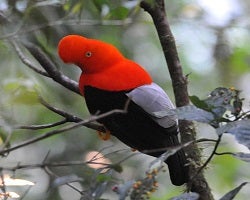
The rainforest is home to lots of species of animals. So many different animals live here that by looking at the rainforest, we have a chance to study adaptations and interactions that may not be found anywhere else.
Ants in Your Plants
Humans and plants have an interesting relationship—we depend on plants for food, for some medicines, and for decoration and even stress relief, if we have houseplants. However, some ants that live in the rainforest have even more complex, or involved, relationships with plants.

Leafcutter ants are little farmers in the rainforest. They cut pieces of leaves off of plants and carry them into storage spaces underground. Here, the ants use the leaf chunks as food to feed another organism—a fungus.
They grow this fungus to feed baby ants, called larvae. The fungus depends on the ants to bring them food, and the ants depend on the fungus to help ant larvae grow. This type of relationship, in which both species benefit, is called mutualism.
Pint-sized Pools
Like ants, some frogs in the rainforest depend on plants to help their babies, or young, grow. Colorful frogs called poison dart frogs depend on tiny pockets of water that gather in the leaves or branching stems of certain plants, especially epiphytes.
After their eggs hatch into tadpoles, the parent frogs move the tadpoles into these water pockets. If a pool runs out of food, or if the water level gets too low, the poison dart frog will carry the tadpoles on its back to a new plant with a larger pocket of water.
These devoted parents may also lay eggs that have no young tadpoles as food for their young.
Show Offs
Though relationships between different species in the rainforest can be interesting, the most amazing things you see in the rainforest are sometimes between a male and female of the same animal species. When some animals are looking to reproduce, or have babies, they need to attract another animal with which they can mate. Oftentimes, in species that have sexual reproduction, it is the male that tries to attract a female.

Some males attract females with amazing dances or colors, using tricks to try to show off for, or impress, a female. The cock-of-the-rock, a type of bird that lives in the undergrowth of the forest, has males with bright red and black color patterns. Five to 20 of these bright males fly, dance and call together in a group called a lek. These birds dance in a small area to try to attract one of the dull-colored females.
When a female arrives at the dancing grounds, the males dance and call even harder. Even with up to 20 males calling, only one male wins out—usually the brightest, the loudest, or the best dancer.
With all the different bright display colors of some animals, the dark, shadowy, green rainforest can be transformed into a beautiful show of moving colors.
Images via Wikimedia commons. Additional image by USFW.
Read more about: Revealing the Rainforest
Bibliographic details:
- Article: Animals of the Rainforest
- Author(s): Dr. Biology
- Publisher: Arizona State University School of Life Sciences Ask A Biologist
- Site name: ASU - Ask A Biologist
- Date published:
- Date accessed:
- Link: https://askabiologist.asu.edu/animals-rainforest
APA Style
Dr. Biology. (). Animals of the Rainforest. ASU - Ask A Biologist. Retrieved from https://askabiologist.asu.edu/animals-rainforest
Chicago Manual of Style
Dr. Biology. "Animals of the Rainforest". ASU - Ask A Biologist. . https://askabiologist.asu.edu/animals-rainforest
Dr. Biology. "Animals of the Rainforest". ASU - Ask A Biologist. . ASU - Ask A Biologist, Web. https://askabiologist.asu.edu/animals-rainforest
MLA 2017 Style

The rainforest holds all kinds of exotic animals, like this ocelot.
Be Part of
Ask A Biologist
By volunteering, or simply sending us feedback on the site. Scientists, teachers, writers, illustrators, and translators are all important to the program. If you are interested in helping with the website we have a Volunteers page to get the process started.

